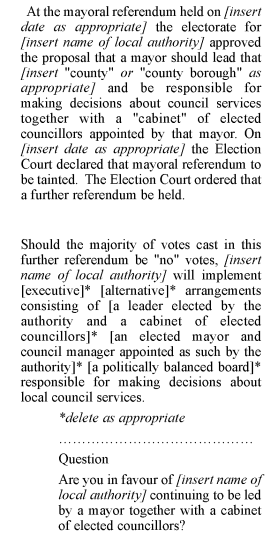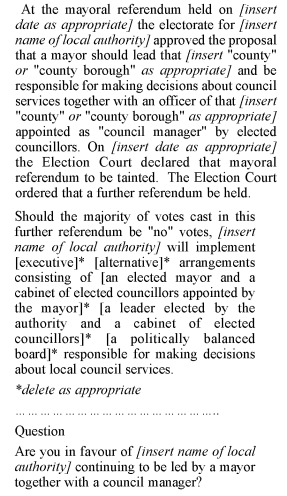- Latest available (Revised) - English
- Latest available (Revised) - Welsh
- Original (As made) - English
- Original (As made) - Welsh
The Local Authorities (Conduct of Referendums) (Wales) Regulations 2004
You are here:
- Wales Statutory Instruments
- 2004 No. 870 (W. 85)
- Regulation 17
Status:
This is the original version (as it was originally made). This item of legislation is currently only available in its original format.
Determination of referendum petitions, and subsequent procedures
17.—(1) Where an election court certifies, as its determination of a referendum petition, that the result of the referendum declared under regulation 14 is or, as the case may be, is not in accordance with the votes cast, any reference (in whatever terms) in the timetable —
(a)included in their proposals under regulation 17(3)(a) or 19(1)(c) of the Petitions and Directions Regulations(1);
(b)regulation 17(7)(a)(ii), or 20(3)(a)(iii) of those Regulations; or
(c)prepared pursuant to any other regulations or an order made under any provision of Part II (arrangements with respect to executives etc.) of the 2000 Act,
to the date of the result of the referendum shall be construed as a reference to the date on which the election court certifies its determination.
(2) Where an election court certifies, as its determination of a referendum petition specifying any of the grounds mentioned in regulation 15(1)(b) to (d), that the referendum was avoided, the local authority concerned shall, not earlier than two months, and not later than three months, after the election court has certified its determination in the matter of the referendum petition, hold another referendum.
(3) On the substantive hearing of a referendum petition for which leave has been granted where the circumstances are as mentioned in regulation 16(4)(a) and (b), the election court shall either —
(a)dismiss the petition; or
(b)allow the petition,
and, where the court allows the petition, it shall declare the referendum to be tainted, and order that a further referendum be held.
(4) Where an election court makes such an order as is mentioned in paragraph (3), the local authority shall hold the further referendum as soon as reasonably practicable after the expiration of the period of five years beginning with the date on which the tainted referendum was held.
(5) If the majority of the votes cast in a further referendum are “yes” votes where the local authority are operating executive arrangements, they shall continue to operate those arrangements unless and until they are authorised or required to operate different executive arrangements or authorised to operate alternative arrangements in place of their existing executive arrangements.
(6) Subject to paragraphs (7), (8) and (9), if the majority of the votes cast in the further referendum are “no” votes, the local authority shall implement the proposals that were their outline fall-back proposals at the time of the tainted referendum.
(7) Where the local authority’s outline fall-back proposals are the executive or alternative arrangements which they were operating at the date of the tainted referendum, subsection (13) of section 27 shall apply to the implementation of detailed fall-back proposals as if, for “in accordance with the timetable mentioned in subsection (4)” there were substituted “as soon as reasonably practicable”.
(8) Where the local authority’s outline fall-back proposals are executive arrangements which involve a form of executive for which a referendum is not required(2) —
(a)subsection (1) of section 29 (operation of, and publicity for, executive arrangements) shall apply for the purpose of enabling the local authority to operate the executive arrangements set out in their detailed fall-back proposals as it applies for the purpose of enabling a local authority to operate executive arrangements in other circumstances; and
(b)subsection (2) of that section shall apply as if, in paragraph (b), for sub-paragraph (i), there were substituted “(i) states that, in consequence of the rejection in a further referendum of the local authority’s existing executive arrangements, the local authority have resolved to operate the different executive arrangements that were described in their outline fall-back proposals at the time of the referendum,”.
(9) Where the local authority’s outline fall-back proposals are alternative arrangements —
(a)subsection (2) of section 33 (operation of alternative arrangements) shall apply for the purpose of enabling the local authority to operate the alternative arrangements set out in their detailed fall-back proposals as it applies for the purpose of enabling a local authority to operate alternative arrangements in other circumstances; and
(b)subsection (2) of section 29(3) shall apply as if, in paragraph (b), for sub-paragraph (i) there were substituted “(i) states that, in consequence of the rejection in a further referendum of the local authority’s existing executive arrangements the local authority have resolved to operate the alternative arrangements that were described in their outline fall-back proposals at the time of the referendum.”.
(10) These Regulations, except where the context otherwise requires, shall apply (so far as relevant), to the conduct of the further referendum as they apply to the conduct of any other referendum, subject to —
(a)in regulation 4 —
(i)in paragraph (1), the omission of sub-paragraph (a);
(ii)in sub-paragraph (b) of that paragraph, the substitution, for “the proposals”, of “the local authority’s existing executive arrangements”;
(iii)in paragraph (vii) of sub-paragraph (c), the substitution, for “a copy of the proposals”, of “a document in which are set out the main features of the local authority’s existing executive arrangements”;
(iv)in paragraph (viii) of that sub-paragraph, the substitution, for “the proposals and”, of “that document and those”;
(v)after paragraph (viii) of that sub-paragraph the insertion of the following paragraph —
“(ix)that the referendum is being held in consequence of the determination of an election court that the referendum last held in the local authority’s area was tainted by reason of a payment of money or other reward made or promised since the referendum in pursuance of a corrupt or illegal practice.”;
(vi)in paragraph (4), the substitution, for “a copy of their proposals”, of “a document in which are set out the main features of the local authority’s current executive arrangements”; and
(vii)in paragraph (5), the substitution, for “the proposals”, of “the main features of the local authority’s current executive arrangements”; and
(b)the substitution of paragraph 1 of Part I of Schedule 1, by —
(c)the substitution of paragraph 2 of Part I of Schedule 1 by —
(11) On the substantive hearing of a referendum petition for which leave has been granted where the circumstances are as mentioned in any paragraph of regulation 16 other than paragraph (4), the election court shall either —
(a)dismiss the petition; or
(b)allow the petition,
and, where the court allows the petition, it shall declare the referendum avoided.
See, in particular, regulations 17(5)(b) and 20(2)(b).
See section 26 of the Local Government Act 2000.
See section 33(3) of the Local Government Act 2000.
Options/Help
Print Options
PrintThe Whole Instrument
PrintThis Section only
Legislation is available in different versions:
Latest Available (revised):The latest available updated version of the legislation incorporating changes made by subsequent legislation and applied by our editorial team. Changes we have not yet applied to the text, can be found in the ‘Changes to Legislation’ area. The revised version is currently only available in English.
Original (As Enacted or Made) - English: The original English language version of the legislation as it stood when it was enacted or made. No changes have been applied to the text.
Original (As Enacted or Made) - Welsh:The original Welsh language version of the legislation as it stood when it was enacted or made. No changes have been applied to the text.
More Resources
Access essential accompanying documents and information for this legislation item from this tab. Dependent on the legislation item being viewed this may include:
- the original print PDF of the as enacted version that was used for the print copy
- lists of changes made by and/or affecting this legislation item
- confers power and blanket amendment details
- all formats of all associated documents
- correction slips
- links to related legislation and further information resources
More Resources
Use this menu to access essential accompanying documents and information for this legislation item. Dependent on the legislation item being viewed this may include:
- the original print PDF of the as made version that was used for the print copy
- correction slips
Click 'View More' or select 'More Resources' tab for additional information including:
- lists of changes made by and/or affecting this legislation item
- confers power and blanket amendment details
- all formats of all associated documents
- links to related legislation and further information resources


